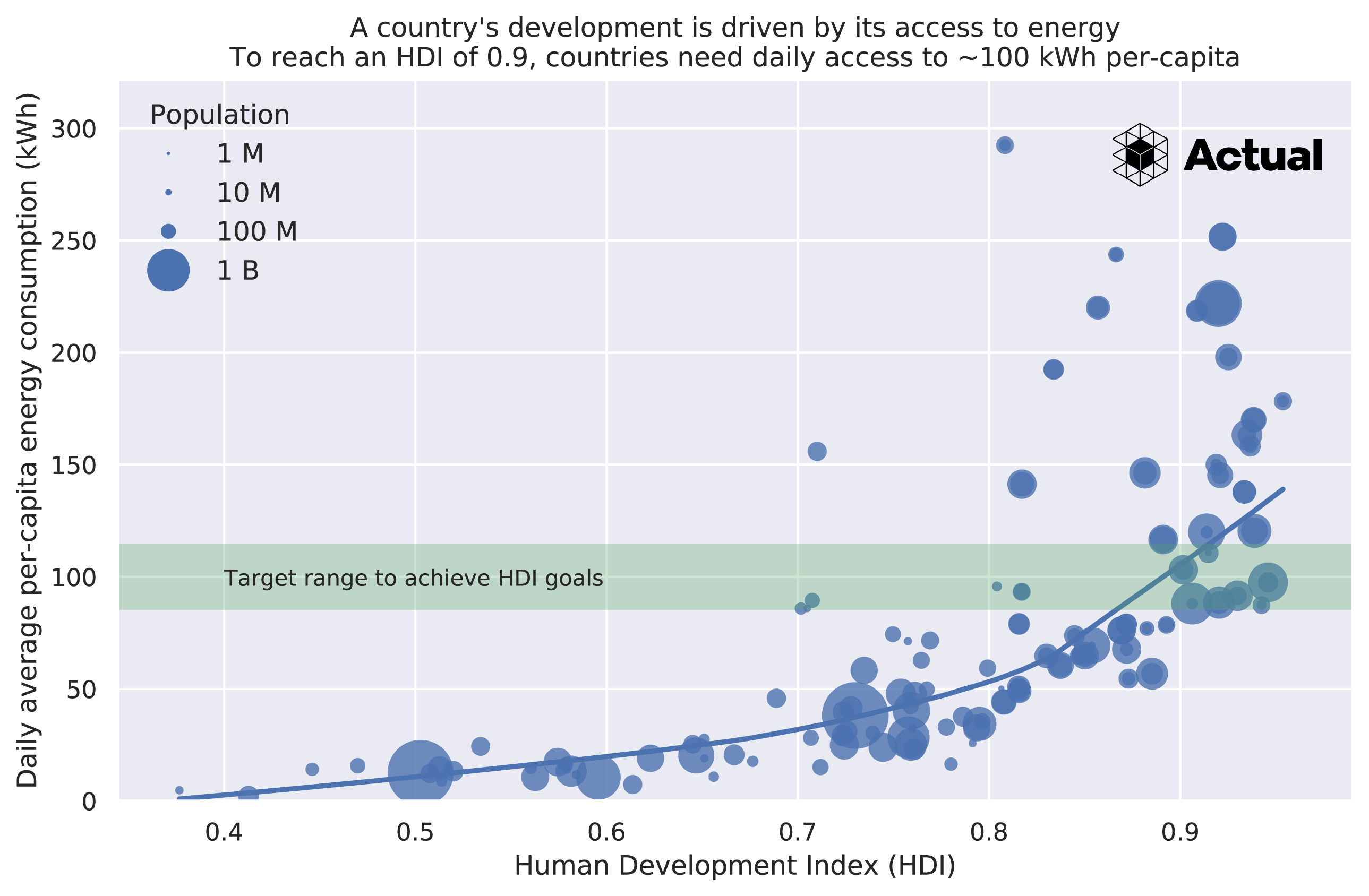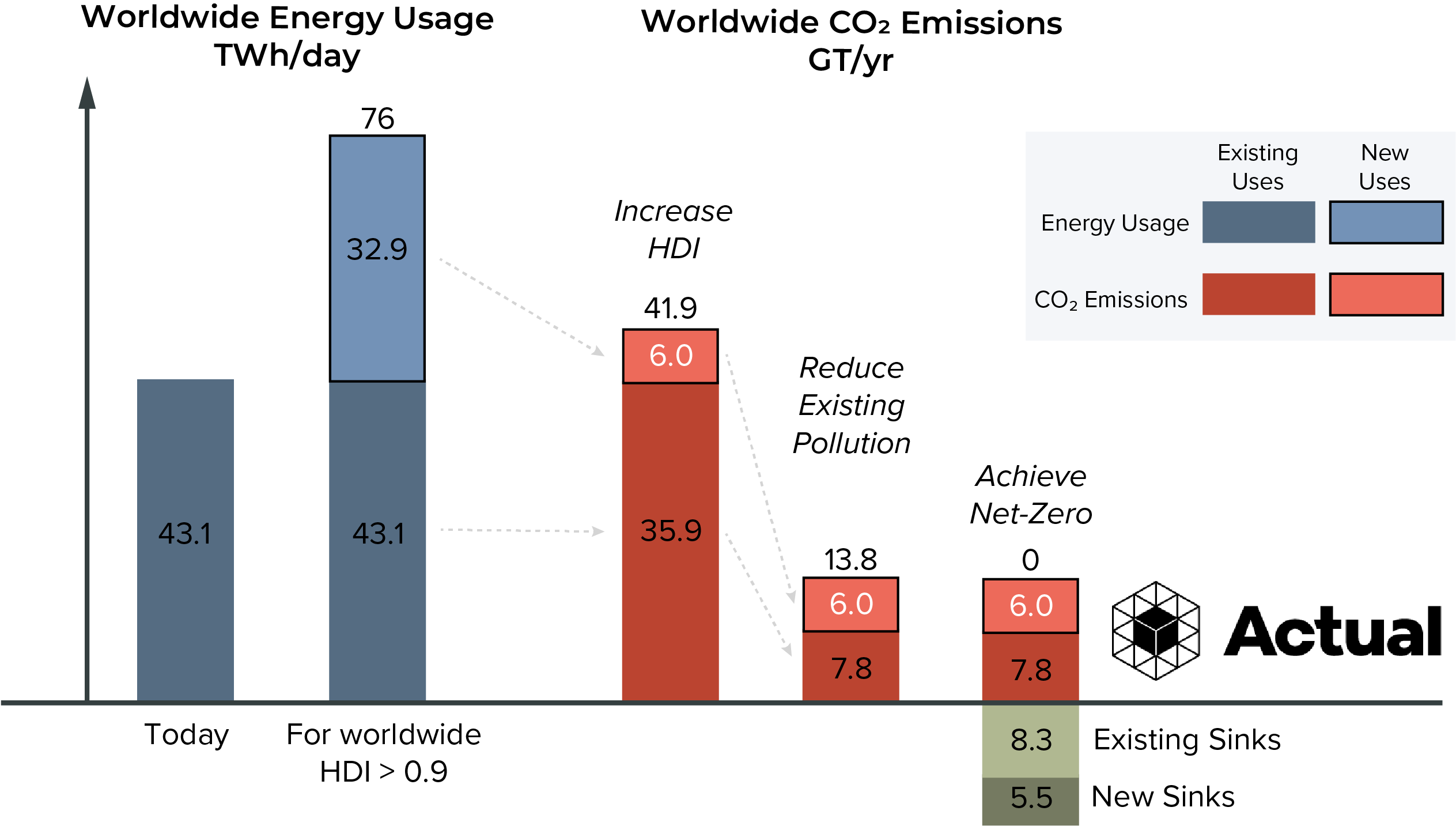11 Jan 2021
Climate change requires we pollute less. Equity requires more energy. Three steps will get us there.

Climate change isn’t a problem for the future; it is here, and it is affecting all of our lives more profoundly with each passing day. Disasters of unprecedented scale occurring simultaneously around the world— record fires caused by unseasonable lightning, early monsoon floods, and fires in Siberia—all make the problem seem intractable. It can easily feel like efforts to mitigate climate change are futile. The Intergovernmental Panel on Climate Change has mapped out a number of ways to keep average warming under 1.5oC. Every single path requires the world to achieve net-zero CO2 emissions by 2050. And the sooner we hit these targets the lower we can keep the total warming.
Over 2 billion people lack access to clean on-site, on-demand water. Areas with clean running water today face the prospect of persistent drought in the near future. Giving more people access to running water and stabilizing access for those who have it today will require more energy. Water capture, pumping, and treatment consumes nearly 10% of the total electricity produced. Now add in the people who don’t have reliable electricity at home (over 3 billion people), or access to medical facilities, communications, public transit, and more. All of these people will need to consume more energy—not less—to meet the basic bar of health, safety, and opportunity.
This energy growth won’t just be in lower and middle income countries. Even in the United States, there are wide swaths of the population who lack access to clean water, internet, and reliable electricity. It is imperative that new projects provide these services in the cleanest, most energy efficient way possible.
How can we respond? The challenge of our time is not to reduce total energy consumption, a callous recipe for magnifying and entrenching inequality. Rather, we must dramatically reduce net CO2 emissions while delivering substantially more energy worldwide to power the projects and solutions that meet the needs of the various communities around the world.
The world’s energy consumption will increase by at least 75%

Energy Data from the World Bank. HDI data from the United Nations Development Programme.
A country’s ability to meet the basic needs of its citizens is dictated by its access to energy. While high energy consumption does not always lead to a high Human Development Index (HDI), a low energy consumption always holds development back. The data is clear: achieving an HDI of 0.9 or higher requires approximately 100 kWh of energy available per person per day. This includes direct energy use at home and work, as well as indirect use for every other need including water pumping, transportation, communications, and in warehouses, factories, schools, by government institutions, and so on.
The closer that a country gets to this 100 kWh target, the better it is able to provide a high quality of life for its citizens. To hit an HDI of 0.9 worldwide would require an additional 32.9 TWh/day of energy generation, a 75% increase from today’s consumption (43.1 TWh/day). While per capita energy consumption is decreasing in the US and holding relatively steady in the EU, it is growing rapidly in China and India. We can expect the rest of the world to follow in the coming years as they race to improve the lives of their citizens.
Reducing emissions means deploying cleaner technologies en masse
Delivering substantially more energy while reducing emissions is entirely possible.
Upgrade or replace existing facilities in countries that meet or exceed the HDI 0.9 goal using these same clean technologies to dramatically reduce emissions. This includes strategies like and natural gas to renewables and nuclear, electrifying fleets of trucks and buses, upgrading homes, businesses, and schools, greening the aviation and automotive sectors, and more.
Increase natural and artificial/synthetic carbon capture capacity to achieve or exceed net-zero worldwide emissions. An increase of at least 5.5 GT CO2/yr (1.6 GT C/yr)is needed.
![image]()
Increasing the energy production to 100 kWh/day for every person on earth will increase CO2 emissions by ~6 GT/yr. It’s possible to achieve net-zero or even net-negative emissions by reducing the pollution from existing energy sources and building carbon capture projects.
Meeting these ambitious goals will cost at least $50 Trillion, and require the construction of millions of individual projects around the world.
Mass customization is key to ensure that projects work in a local context
Infrastructure development has historically been a tale of extremes. At one extreme are bespoke solutions developed from a clean sheet for each site. This practice drives cost and timelines, and limits both the cross-pollination of ideas and the establishment of best practices. At the other extreme are cookie cutter solutions, which may be fast to deploy but lack attention to local contexts and needs, ultimately leaving gaps which need to be filled in later. A middle ground is needed, where projects are responsive to local conditions, but can take advantage of the amplifying cycles of cost, expertise, and speed from mass production.
ACTUAL’s solution is to layer common building blocks to create solutions tuned to local needs. Local problems need input from local communities. While there’s plenty of capital seeking return from building new infrastructure and tackling the challenge of climate change, there’s a gap in the project conceptualization phase. Many local originators are experts in the problem they’re trying to solve—logistics, medicine, even entertainment—but are not experts in the specific infrastructure building blocks that are needed, like solar panels, batteries, water, and communications technologies. At the same time, many of the solutions that local originators are familiar with are regressive and will make climate change worse. By providing these local originators with the tools to help design, analyze, iterate, and communicate the solutions to support their businesses, ACTUAL can bridge the gap. Newly empowered to solve problems in their local context, originators can pull in help as needed, taking advantage of lessons learned from projects using similar building blocks around the world. This enables frontline communities to oversee the deployment of capital which directly solves their climate challenges.
Our software enables domain experts and communities to plan sustainable infrastructure projects with snap-together ease and to rapidly assess their environmental and social impacts. Drawing on inspirations as varied as urban planning, game engine design, journalistic data visualization, and scientific computing, we are reimagining how the cities and communities of tomorrow will take shape. Contact us to learn more.
Illustration by Milly Que.
More recent blog posts
28 Sep 2023

ACTUAL Brings Sustainability Transformation Platform to United Nations Global Compact

Dr. Karthik Balakrishnan
+2 more
ACTUAL joins largest corporate sustainability initiative in the world to contribute to the development, implementation and disclosure of responsible business...
19 Dec 2022

Turning over a New Leaf: How FEMA is Addressing Gaps in Tribal Nations’ Disaster Preparedness Planning

Genevieve Olsen
In the wake of increasingly frequent and powerful natural disasters, many Native American tribes and organizations have been vocal about...
19 Dec 2022

To Reach Net-Zero, We Need to Talk About the Maritime Industry

Genevieve Olsen
When we think about reducing GHG emissions, we often think of what’s on land or in the air. But what...
